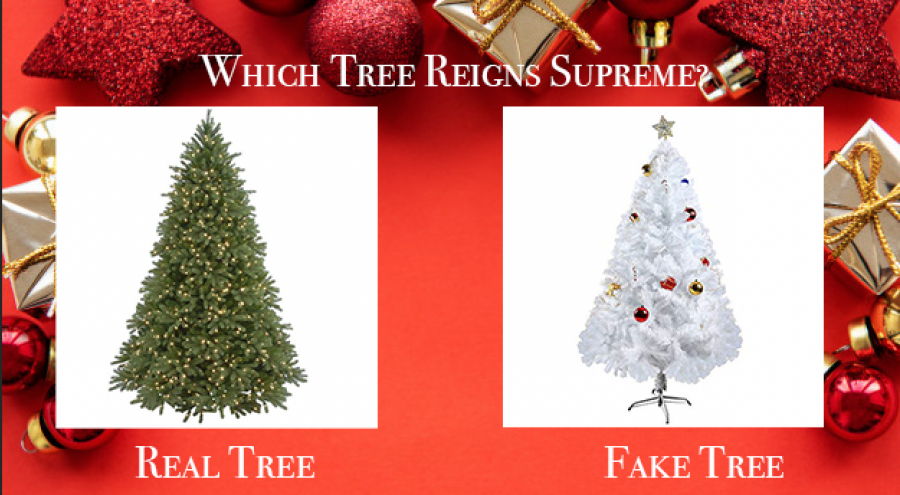Real Versus Fake Christmas Tree Debate
The Scroll writers debate the Christmas Tree issue below
December 15, 2020
The debate has gone on since the tradition of a bringing a tree into the home for the holidays: whether or not to get a real Christmas tree of a fake Christmas tree. Here are two sides of the argument:
Pro Fake Tree: Written by Danyale Schlender
Having a fake tree instead of a real Christmas tree is an annual festive debate, however, fake Christmas trees reign supreme for the following reasons:
Festivity aside for the moment, financially, artificial trees are the way to go. On Amazon, a seven-foot artificial tree can be found for prices ranging from $80-$120, whereas the average real tree can be found anywhere in a range from $78-$110. Assuming you buy a new Christmas tree every year, this can add up.
Global marketing research firm Nielsen Corporation, commissioned a survey and concluded that the average artificial tree owner keeps their tree for 10 years. Roughly speaking, $80 every 10 years is a phenomenally better deal than $780 over the course of ten years just on Christmas alone. Of course excluding presents and decorations to cover said tree.
Another aspect to having a fake tree is that they are hypoallergenic. Some people are allergic to the scent of pine or just certain aspects of nature. So, having a fake tree would be easier on the sniffer. On top of that, for lovers of the “Christmasy” scent, scented pinecones can be an additional purchase to liven up the smells of the house. Not to mention, festive scented candles are a popular aromatic Christmas tradition.
Our furry friends should also play into our decision of which tree to pick. Some pets, mostly dogs, have very sensitive allergies to pine just like humans. So, getting a fake tree could benefit them as well. Those who own cats know they get wherever they fit. “If I fits I sits” said every cat ever, and the Christmas tree is no exception. Since the man-made Christmas tree has metal branches, cats have a harder time gripping onto it, where the real tree has wooden branches and cats can grip their little demon claws into it easier.
Another interference from our four-legged felines is the mess they can cause with real trees. Some cats climb real trees and knock off pine needles or, worst case scenario, knock over the entire tree water included. Conveniently, fake trees don’t have easily detached needles making them 100 percent mess free. Animals also have a habit of drinking the tree’s water instead of their own because it has flavoring to it.
Another one of the many benefits to having a fake tree is not having to water it and it being safer for its co-inhabiters. Fires can be started from the Christmas trees due to not being properly watered. The lights used to decorate the tree have a tendency to heat up and when the tree is dry the lights can start a fire, making fake trees safer due to the less likely possibility of them catching fire and making them water salvaging as well.
What could be more festive than bugs and rodents? Unlike artificial trees, real trees attract bugs like other other household plants and where there are bugs, there are rodents. So the absence of insects and pests is just yet another positive contribution a fake tree comes with.
Though a real plant may be appealing to some, breaking from this tradition can be just as satisfying. Traditional Christmas trees can be boring while man-made Christmas trees can be exciting and come in different sizes and colors. And, they will stay that color for the entirety of the holidays. So, you won’t have to worry about the beautiful focal point of the room wilting.
Pro Real Christmas Tree: Written by Ryan Vasquez
The debate between getting a real or fake Christmas tree is a common one, and widely discussed. There are reasons for both, but ultimately, real trees are better and overall more festive.
While contemplating whether to get a real tree or a fake tree, there are many aspects to consider. Many would argue that selling real trees is bad for the environment. Why cut down all that forestry just for some holiday? What these people fail to realize is that real trees are biodegradable and recyclable, and Christmas tree farms plant another tree after one is harvested. Thus, while it may seem irresponsible to cut down millions of trees every year, it is less hazardous than throwing away plastic trees that don’t degrade.
Another point to consider is that real trees are often cheaper than fake trees. For example, a real Christmas tree 5 to 6 feet tall at Lowe’s is about 100 dollars, but a pre lit fake Christmas tree at Lowes of the same size is over 200 dollars!
Not only are they economically friendly and cheaper, but real Christmas trees are a strong way to keep family traditions going. Christmas is a time to be with family, and picking out a Christmas tree from a farm is a great way to spend time and bond with loved ones.
As well as keeping up the tradition of going to pick out a tree, real trees are superior when it comes to decorating. The smell of a real tree while adorning it makes the holidays even more festive. In fact, after The Scroll conducted an online poll, the results showed that 86 percent of voters would rather have a real tree.


Michelle • Dec 15, 2020 at 6:58 pm
Loved the article. I think I might be convinced that fake trees are best now! But what could be more festive than bugs and rodents or feline destroyers? . Another great read!